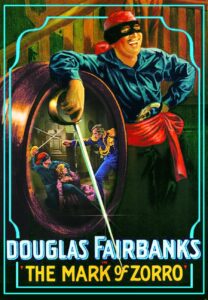Silver Showcase has nearly 80 feature length movies that we could screen at your event. Listed here are only a handful of what is available…
(NOTE: films that are not in the public domain will require an extra fee to cover the licensing fee.)
THE MARK OF ZORRO
(Douglas Fairbanks Picture Corporation/United Artists, November 27, 1920)
“The Mark of Zorro [with Douglas Fairbanks] contains some of the most jaw-dropping stunts I’ve ever seen this side of Jackie Chan.” (Steven D. Greydanus, Decent Film Guide.)
Starring Douglas Fairbanks, Sr., Marguerite de la Monte, Robert McKim and Noah Beery.
This first Zorro film is the grandfather of all action/adventure films and all super hero avengers that followed. Batman, in particular, very clearly stole many things from this movie. It’s a great romp and loaded with wry humor, exciting and funny sword fights and classic Fairbanks stunts (which he did himself!), not to mention that famous Fairbanks smile. You’ll laugh! You’ll cheer! You’ll love The Mark of Zorro! (This film is in the public domain.) (1976 Eastman film stock, density sound track)

This print features an outstanding theatre organ score written and performed by the legendary Gaylord Carter (1905-2000), “the dean of theatre organists,” who began accompanying films in 1915 and was soon accompanying movies in some of the biggest theaters in Los Angeles and later around the world. Carter’s career spanned several continents and some 70 years. Carter was friends with the great film comedian Harold Lloyd and provided music for many of Lloyd’s own films. Lloyd used to tell Carter to “play under, it’s when they’re NOT laughing that I need YOU.” Carter learned his lesson well. His scores always support and never overtake the films. This great sound track has never been released to home video.
____________________________________________________________________________________________________
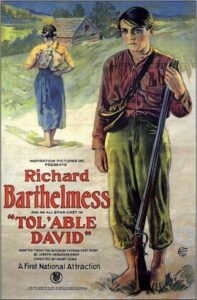
TOL’ABLE DAVID
(Inspiration Pictures, December 31, 1921)
This landmark American film stars Richard Barthelmess, Gladys Hulette and Ernest Torrence.
Tol’able David is a gripping drama filmed on location in the Shenandoah Valley of Virginia just a few miles from where director Henry King grew up. Author Joseph Hergesheimer wrote the original story in the very house that is featured in the film. The influence of Thomas Ince and D.W. Griffith is seen in the finely honed characters and in the editing, particularly in the climactic scene where it cuts back and forth between the fight to the death struggle and the serenity of the quiet village. This only serves to make the battle even more terrorizing.
The film uses the Biblical story of David and Goliath set in a rural American village of the early 20th century to tell a story of the love of family, of youth’s impatience and of accepting responsibility. The final battle is among the most intense scenes ever filmed. Brilliantly supported by a masterful score by Gaylord Carter, it reaches across the decades, grabs hold of us and never lets go.
It is also a great document of Americana as it shows us life in a rural village of a century ago, a town without electricity or telephones or motor cars, a time when fly chasers were waived over the dinner table before eating, and when families gathered in the evenings to read from the Bible by the light of kerosene lamps.
One of the great American films, “Tol’able David” influenced filmmakers around the world. A century later it continues to surprise and amaze audiences with its engaging performances, inviting on-location photography and almost unbearably intense drama.

This excellent 16mm print contains the school house dance scene in original red and green tints, and a terrific and authentic theatre organ accompaniment by the “dean of theatre organists,” Gaylord Carter (1905-2000), who began accompanying films as a teenager in 1915 and was soon accompanying movies in some of the biggest theaters in Los Angeles and later around the world. Carter’s career spanned several continents and some 70 years. This terrific sound track has never been released to home video. (This film is in the public domain.)
______________________________________________________________________________________
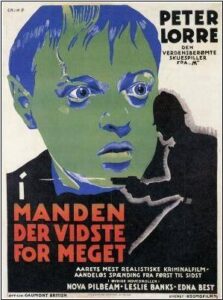
THE MAN WHO KNEW TOO MUCH
(Gaumont British Picture Corporation, December, 1934) Starring Peter Lorre, Leslie Banks and Edna Best.
This is Alfred Hitchcock’s first version of this story and Peter Lorre’s first English language picture. Often seen in poor dupes with poor sound tracks, this print boasts excellent picture and sound.
_______________________________________________________________________________________________
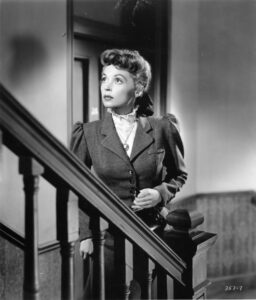
MY GIRL TISA
(United States Pictures/Warner Bros., released February 7, 1948) with Lilli Palmer, Sam Wanamaker, Akim Tamiroff, Alan Hale and Stella Adler.
This is a lovely film that you’ve probably never heard of. It tells the story of a young immigrant coming to America and working hard to become a citizen. Set in 1905 New York City this movie is brimming with wonderful touches of Americana. The strong work ethic and naive spirit that empowered many immigrants and also got them into trouble is portrayed sincerely and without shame. Dismissed in its day, twenty first century audiences respond enthusiastically to the faith and the goodness of a strong America. Strong performances by a truly great cast lift this film well above the average. (1961 Canadian Kodak film stock, variable area sound track)
______________________________________________________________________________________________


A 20th CENTURY FOX PRODUCTION. Premiered July 16, 1942. Starring Monty Woolley, Roddy McDowall, Anne Baxter, Otto Preminger, J. Carrol Naish, Peggy Ann Garner. Directed by Irving Pichel.
Mr. Howard, well educated and more than a bit of a curmudgeon, is caught on a fishing holiday in France when the Germans invade in WWII. Some guests of the inn where he is staying work for the League of Nations and must go to Switzerland, so they ask Mr. Howard to take their children to the safety of England. He detests children but finally decides it is his duty, so he agrees to the task. As they make their way across occupied France, other children attach themselves to the little group.
The unlikely pairing of 54-year-old Monty Woolley and 13-year-old Roddy McDowall proves to be inspired. The chemistry between them on the screen is palpable and drives this tensely grim and heartbreaking as well as often funny movie. The New York Times called this film “a charming and moving testament against the background of the war. ‘The Pied Piper’ is also irresistibly entertaining.” (Agfa and 3M composite print in near mint condition. Variable area sound track)
________________________________________________________________________________________
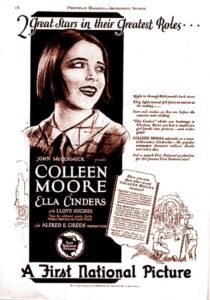
ELLA CINDERS
(John McCormick Productions/First National, June 6, 1926) With Colleen Moore, Lloyd Hughes, Vera Lewis, Doris Baker, Emily Gerdes, Jed Prouty and Jack Duffy.
Delightful and endearing silent film starring the wonderful Colleen Moore as the comic strip heroine, Ella Cinders. Based on the comic strip of the same name which was based on the folk tale, “Cinderella” which has origins dating back some four hundred years.
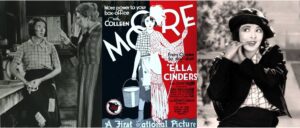
In this 20th century telling of the story, poor Ella (Colleen Moore) is a slavey to her wicked step-mother and step-sisters. The only kindness she knows is from her boy friend, Waite Lifter (Lloyd Hughes). When Ella learns of a beauty contest offering a Hollywood contract as first prize she enters and wins, much to the dismay and disgust of her step-mother. But upon arrival in Hollywood she learns that the contest was a scam, the perpetrators are in jail, and Ella has no Hollywood contract. So, what’s a poor waif to do? Why, break into the movies, that’s what! Will she succeed? Will she live happily ever after? After all, this IS a fairy tale!
This charming film presents some great views inside a real 1920s movie studio. One wonderful and all too brief scene has her encounter the legendary silent film comic Harry Langdon in the middle of shooting a scene. On the spot Langdon works her into the action.
All that survives of this great little feature is the Kodascope version, issued for non-theatrical screenings following the first release. This is that version, but it also carries another great theatre organ sound track by “The Dean of Theatre Organists,” Gaylord Carter.

